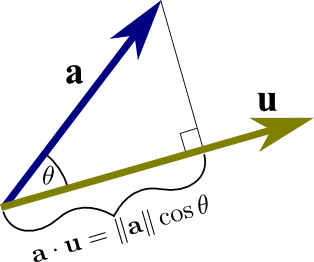 projection onto a unit vector" width="" height="196" />
projection onto a unit vector" width="" height="196" />To create your own interactive content like this, check out our new web site doenet.org!
But first, notice that the question “how much of $\vc$ is pointing in the same direction as the vector $\vc$” does not have anything to do with the magnitude (or length) of $\vc$; it is based only on its direction. (Recall that a vector has a magnitude and a direction.) The answer to this question should not depend on the magnitude of $\vc$, only its direction. To sidestep any confusion caused by the magnitude of $\vc$, let's scale the vector so that it has length one. In other words, let's replace $\vc$ with the unit vector that points in the same direction as $\vc$. We'll call this vector $\vc$, which is defined by $$\vc = \frac<\vc><\|\vc\|>.$$
 projection onto a unit vector" width="" height="196" />
projection onto a unit vector" width="" height="196" />
However, the geometric formula \eqref is not convenient for calculating the dot product when we are given the vectors $\vc$ and $\vc$ in terms of their components. To facilitate such calculations, we derive a formula for the dot product in terms of vector components. With such formula in hand, we can run through examples of calculating the dot product.